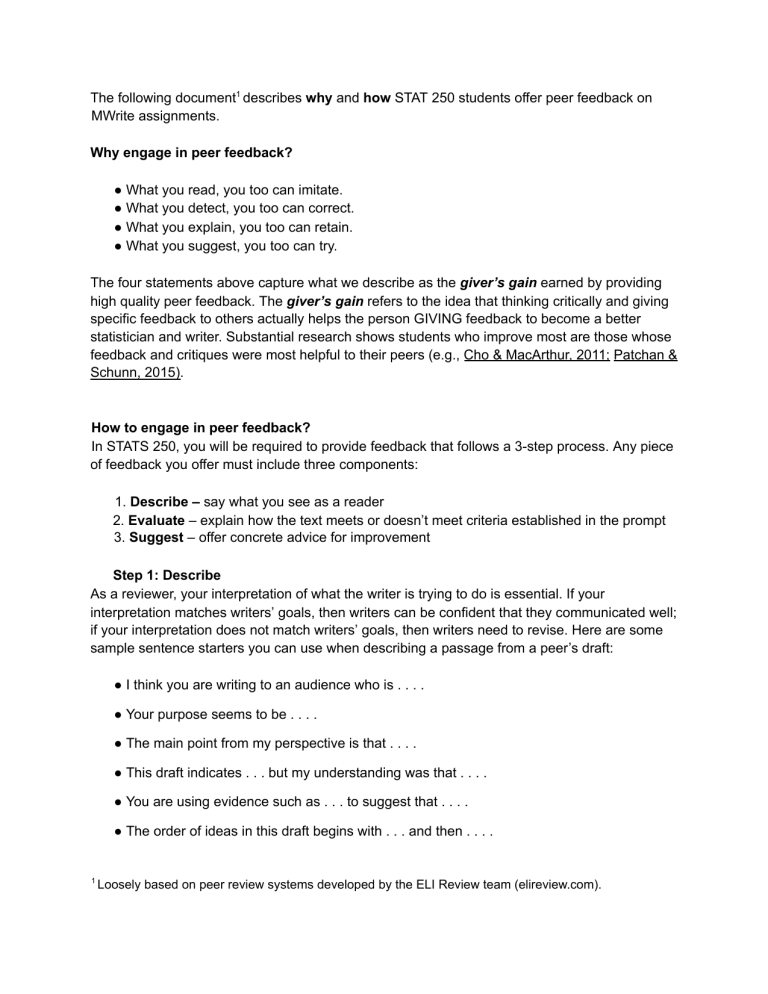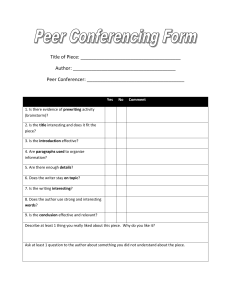
The following document1 describes why and how STAT 250 students offer peer feedback on MWrite assignments. Why engage in peer feedback? ● What you read, you too can imitate. ● What you detect, you too can correct. ● What you explain, you too can retain. ● What you suggest, you too can try. The four statements above capture what we describe as the giver’s gain earned by providing high quality peer feedback. The giver’s gain refers to the idea that thinking critically and giving specific feedback to others actually helps the person GIVING feedback to become a better statistician and writer. Substantial research shows students who improve most are those whose feedback and critiques were most helpful to their peers (e.g., Cho & MacArthur, 2011; Patchan & Schunn, 2015). How to engage in peer feedback? In STATS 250, you will be required to provide feedback that follows a 3-step process. Any piece of feedback you offer must include three components: 1. Describe – say what you see as a reader 2. Evaluate – explain how the text meets or doesn’t meet criteria established in the prompt 3. Suggest – offer concrete advice for improvement Step 1: Describe As a reviewer, your interpretation of what the writer is trying to do is essential. If your interpretation matches writers’ goals, then writers can be confident that they communicated well; if your interpretation does not match writers’ goals, then writers need to revise. Here are some sample sentence starters you can use when describing a passage from a peer’s draft: ● I think you are writing to an audience who is . . . . ● Your purpose seems to be . . . . ● The main point from my perspective is that . . . . ● This draft indicates . . . but my understanding was that . . . . ● You are using evidence such as . . . to suggest that . . . . ● The order of ideas in this draft begins with . . . and then . . . . 1 Loosely based on peer review systems developed by the ELI Review team (elireview.com). ● The style of this draft makes me expect . . . . ● Your voice as a writer comes across . . . . ● I like how you _____ because . . . . Notice that many of these sentence starters might lead to praise rather than criticism. That’s great! Writers need to know why reviewers say “good job” just as much as they need to know why reviewers say “change this.” A good description of what the writer has accomplished makes a praise comment helpful because such comments tell writers what to keep doing next time. Step 2: Evaluate This part of a peer review comment tells writers how well they are achieving a specific goal. Because this evaluation follows your description of the draft, writers should understand that your critique is about the draft, not about them personally. Still, getting an evaluation always feels personal, so be respectful. When evaluating a passage, consider where the text falls between the descriptive pairs listed below. Is the passage you’re reviewing… accurate ….or…. broad balanced ….or…. partial cohesive ….or…. fragmented clear ….or…. confusing too many quotes ….or…. too few quotes thorough ….or…. brief compelling ….or…. strightforward/plain interesting ….or…. predictable effective ….or…. limited refined ….or…. unfinished In a positive evaluation, your comments tell writers what they should keep doing. In a critique, your comments tell writers what they may consider changing. It’s also good to keep in mind that a general statement, even a positive one, can be less valuable. Simply saying “good job!” without explaining what you mean may not have the effect of making the writer feel good about their work. Step 3: Suggest In the final part of a comment, offer the writer a way to revise. Try to give feedback about what to try next instead of saying how to fix the problems. Consider these examples: ● Feedback about next steps: I think you need to expand your passage on the variability of the data so that your counter-argument will be stronger. Try starting with the lecture on standard deviation we covered last week. ● Feedback that Fixes: Reread the lecture notes on standard deviation we covered last week, and put the major points from it after paragraph three to strengthen the counter-argument. Feedback that fixes limits writers’ decision-making, and your goal as a reviewer is to help writers have a better sense of their options and next steps. You can do this even when you are commenting on a positive feature, letting the writer know what they can do again next time. Because options and next steps are critical for writers, ending your comment with a good question is one of the most helpful things you can do. Your question sends writers to find their own answers, and that discovery process is important for improving their writing. Here are some question starters that you can use as suggestions: ● How can you rearrange the parts of this draft so that your best example (________) gets the most attention? ● How can you expand this draft to better address ______? ● What are the two or three things that no reader should miss, and how can you make sure those things are repeated in the draft a couple of times? ● How can this draft move readers more quickly toward ______? ● How can you revise your words and sentences so that this draft sounds more ______? Offering helpful feedback about next steps is hard to do for peers (and professors!), so be patient with yourself as you learn to offer good suggestions. Putting it all together Comments written according to the describe-evaluate-suggest pattern have the information writers need to revise. These comments tend to make sense even if readers do not have access to the original draft or the original assignment. Because reviewers have said what the draft is doing, how well it is meeting the criteria, and what steps are needed to improve, writers can follow reviewers’ thinking. Writers are likely to trust that reviewers have read their drafts well, and they have the information they need to revise. In the following comment, try to label where the reviewer describes, evaluates, and suggests: Your main argument seems to be that the relationship between the two variables analyzed (mean teacher salary and mean SAT score) is confounded by other variables (you mention high school class size). You address the fact that other variables might influence the relationship between mean teacher salary and mean SAT score. I think it could be useful to provide a more thorough explanation of why mean high school class size acts as a confounder and provide an explicit list of other variables you think might influence the focal variables of the study. How might this impact how people view the relationship between teacher salary and mean SAT scores? Why is this important? Now, reread the comment and answer these questions: ● Does this comment describe the draft? Does it help the writer understand the draft any better? ● Does this comment evaluate the draft? Does it help the writer measure progress toward the assignment goals? ● Does this comment suggest a revision? Does it offer any specific advice for improvement? ● Does this comment show respect for the draft and the writer? If you answered “yes” to all of these questions, then you agree with us that this is a high-quality comment in terms of its helpfulness.


